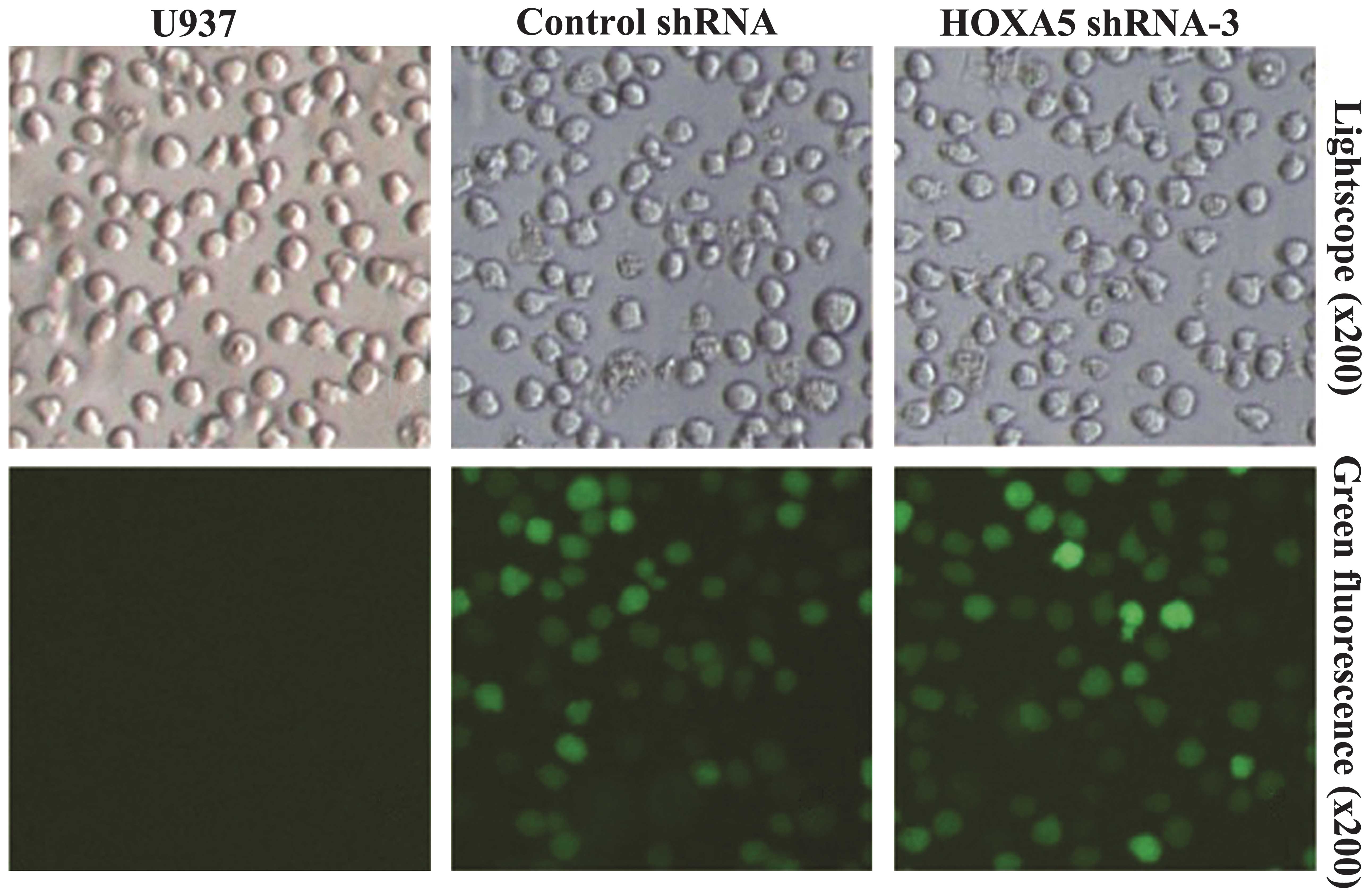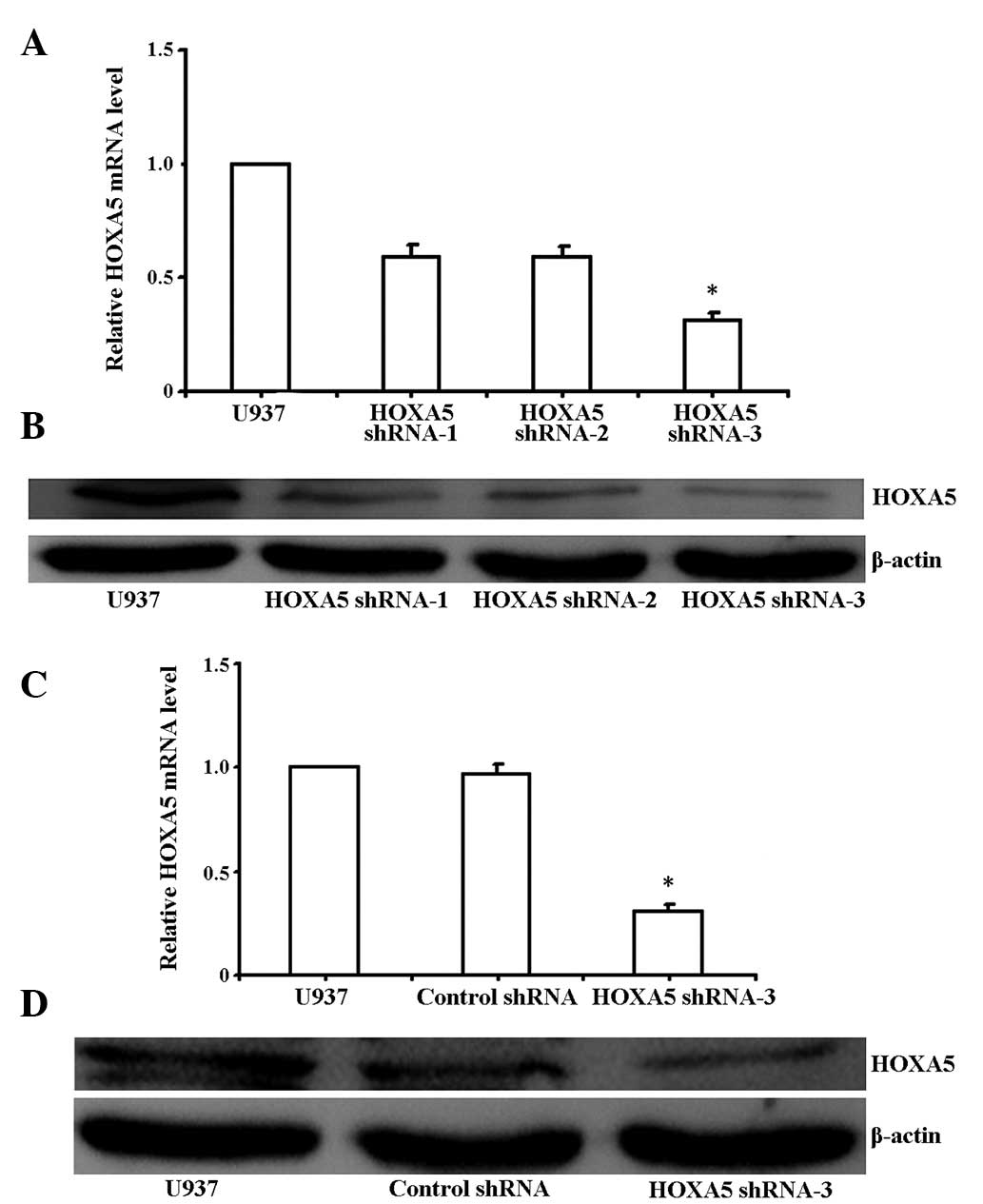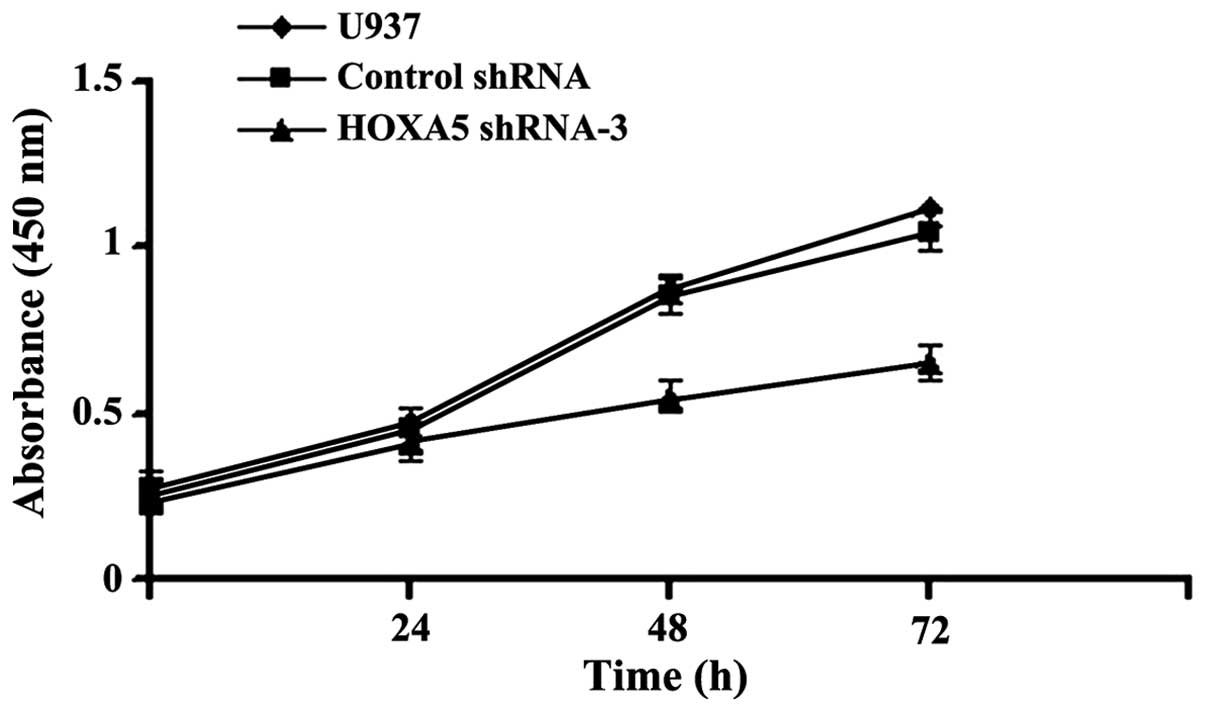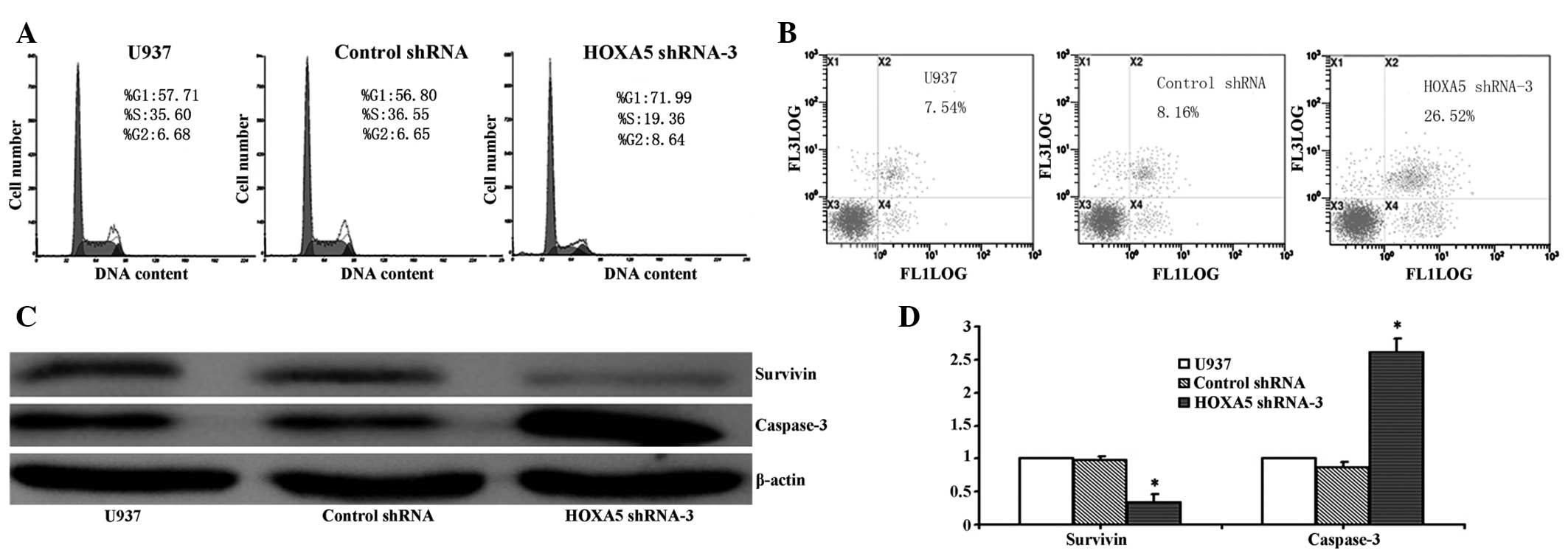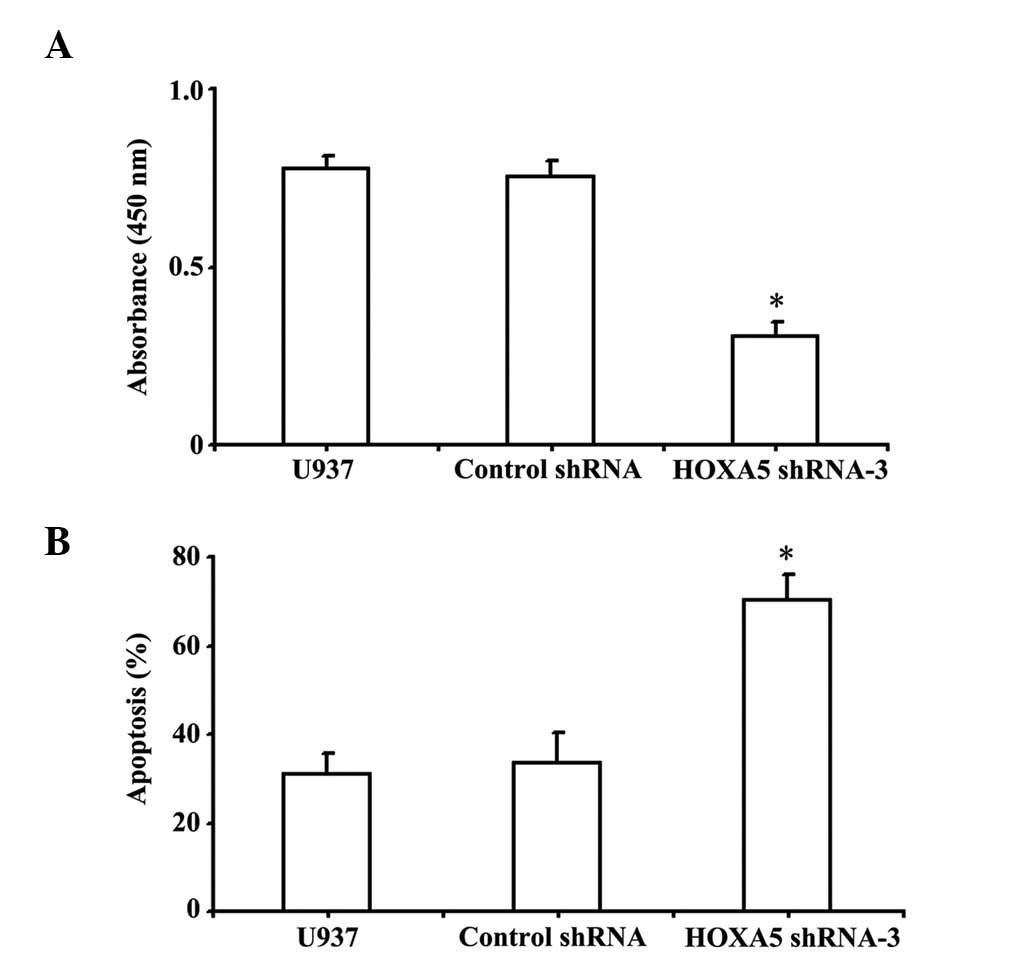Knockdown of homeobox A5 by small hairpin RNA inhibits proliferation and enhances cytarabine chemosensitivity of acute myeloid leukemia cells
- Authors:
- Published online on: September 15, 2015 https://doi.org/10.3892/mmr.2015.4331
- Pages: 6861-6866
Abstract
Introduction
Acute myeloid leukemia (AML) is a hematopoietic stem cell disorder characterized by the clonal proliferation of myeloid precursors with inhibition of differentiation, leading to the accumulation of immature cells at various stages and reduction in the production of normal hematopoietic components: Erythrocytes, platelets and mature granulocytes (1). AML is the most common lethal hematological malignancy in children and young adults, and represents 3% of all cancer cases, and accounts for ~257,000 cases of cancer-associated mortality worldwide annually (2). With conventional intensive chemotherapy, the prognosis for patients with AML remains poor, with an overall long-term survival of <30% in patients younger than 60 years old, and only 10–20% for older patients (3). Previous studies have demonstrated that therapeutic strategies targeting tumor cell growth and survival signaling pathways may provide a novel strategy to optimize AML therapy (4–6). Although numerous molecules have been identified as potential targets, only a few have a pivotal role in tumor cell proliferation and survival (7). Therefore, the identification of novel therapeutic targets and the development of novel therapeutic strategies that may effectively regulate cellular function appear to be of central importance.
Homeobox (HOX) genes comprise a large family of homeodomain-containing transcription factors, present in four separate clusters (A–D), which are key regulators of embryonic development, hematopoietic differentiation and leukemogenesis (8). Previous studies demonstrated that increased HOXA9 and Meis homeobox 1 expression were strongly associated with cytogenetically normal-AML (9,10). HOXA5 is a member of the HOX gene family, which is known to have important roles in embryonic development and in the regulation of the differentiation process of adult cells. In addition, HOXA5 has been implicated in the differentiation of epithelial and hematopoietic cells (11). Overexpression of HOXA5 in hematopoietic progenitors results in increased granulocytic/monocytic differentiation, but reduced erythroid/megakaryocytic differentiation, which suggests that HOXA5 functions as an important regulator of hematopoietic lineage determination and maturation (12).
Studies of homeobox genes in leukemic cells provided evidence that aberrant expression may have an important role during leukemogenesis (13,14). However, whether HOXA5 regulates the proliferation and apoptosis of leukemia cells, as well as the nature of the underlying mechanism, remain unknown. The aim of the present study was to investigate the potential role of HOXA5 in the development of leukemia.
Materials and methods
Cell culture
Human U937 AML cells were purchased from the Shanghai Institutes for Biological Sciences of the Chinese Academy of Sciences (Shanghai, China) and cultured in RPMI-1640 medium (GE Healthcare Life Sciences, Logan, UT, USA) supplemented with 15% fetal bovine serum (GE Healthcare Life Sciences) and 1% antibiotics (100 IU/ml penicillin and 100 µg/ml streptomycin; GE Healthcare Life Sciences), at 37°C in a humidified atmosphere containing 5% CO2.
GFP assays
Following transfection, GFP expression in U937 cells was observed under a fluorescent microscope (Olympus DP71; Olympus, Tokyo, Japan) and then the percentage of GFP-positive cells was estimated by flow cytometry (FACS FC500; Beckman Coulter, Brea CA, USA).
In vitro transfection with shRNA
Three pairs of shRNA sequences targeting HOXA5, termed HOXA5 shRNA-1, -2, -3, and one scramble sequence that served as a control were designed and synthesized by Shanghai GenePharma Co., Ltd. (Shanghai, China). Their target sequences are shown in Table I. The U937 cells in logarithmic growth phase were seeded into a six-well plate at a density of 5×105 cells/well and transfected using HiPerFect (Qiagen, Inc., Valencia, CA, USA) according to the manufacturer's instructions. After 48 h, transfection efficiency was examined under the fluorescence microscope. Reverse transcription-quantitative polymerase chain reaction (RT-qPCR) and western blot analyses were performed to determine inhibitory efficacy.
RT-qPCR
Total RNA was isolated using TRIzol® reagent (Invitrogen Life Technologies, Carlsbad, CA, USA), according to the manufacturer's instructions. A total of 2 µg total RNA was reverse transcribed into cDNA. The reverse transcription reaction was performed using a PrimeScript™ RT reagent kit with gDNA Eraser (Takara Biotechnology Co., Ltd., Otsu, Japan) and RT-qPCR was performed using a SYBR Green reaction kit (Takara Biotechnology Co., Ltd.) on an ABI PRISM 7500 real-time PCR system (Applied Biosystems, Foster City, CA, USA). The reaction system of the PCR was composed of SYBR green reagent, forward primer, reverse primer, template cDNA and nuclease-free distilled water. The PCR conditions were as follows: 95°C for 30 sec, 40 cycles of 95°C for 5 sec, and 60°C for 34 sec. The PCR primer sequences for the RT-qPCR were as follows: Forward: 5′-TGCACCACCACCTGCTTAGC-3′ and reverse: 5′-GGCATGGACTGTGGTCATGAG-3′ for human GAPDH; and forward: 5′-AGCCACAAATCAAGGACACA-3′ and reverse: 5′-GCTCGCTCACGGAACTATG-3′ for HOXA5. qPCR for each gene of each cDNA sample was assayed in triplicate. The results were calculated using the 2−∆∆Ct method using the following equations: ΔCt = Ct(target gene) − Ct(actin); ΔΔCt = ΔCt(HOXA5 shRNA-treated cells) − ΔCt(untreated control).
Western blot analysis
The cells were washed twice with cold phosphate-buffered saline (PBS) and harvested in 100 µl cell lysis buffer (Nanjing KeyGEN Biotech Co., Ltd., Nanjing, China) containing protease inhibitors (Nanjing KeyGEN Biotech Co., Ltd.). A total of 50 µg extracted proteins were separated on 10% SDS-PAGE (Beyotime Institute of Biotechnology, Shanghai, China), and then transferred electrophoretically onto a poly-vinylidene difluoride membrane (EMD Millipore, Bedford, MA, USA). The membranes were blocked with 5% skimmed milk for 2 h at room temperature, and washed three times with Tris-buffered saline with Tween-20 [TBST; 50 mM Tris-HCl (pH 7.6), 150 mM NaCl, 0.1% Tween-20], and then incubated overnight at 4°C with specific antibodies. The primary antibodies used were as follows: Rabbit monoclonal anti-HOXA5 (ImmunoWay Biotechnology, Newark, DE, USA; 1:1,000 dilution; cat. no. YT2211), rabbit polyclonal anti-survivin (Wuhan Boster Biological Technology, Ltd., Wuhan, China; 1:300 dilution; cat. no. BA4055-2), rabbit polyclonal anti-caspase-3 (Wuhan Boster Biological Technology, Ltd.; 1:300 dilution; cat. no. BA2885-2) antibodies, and rabbit polyclonal anti-β-actin (Beyotime Institute of Biotechnology, Haimen, China; 1:1000 dilution; cat. no. BA2305) antibody was used as a loading control. The following day, after washing with TBST, the membrane was incubated in horseradish peroxidase-labeled goat anti-rabbit immunoglobulin G (1:5,000; cat. no. ZB-5301; OriGene Technologies, Beijing, China) for 1 h at room temperature. Finally, images were captured using a FluorChem FC2 gel imaging system (Alpha Innotech, San Leandro, CA, USA).
Cell proliferation assay
Cell proliferation was determined using a Cell Counting kit-8 (CCK-8) assay (Dojindo Molecular Technologies, Inc., Kumamoto, Japan). The cells were plated at a density of 1–2×104 cells/well in 96-well culture plates. Following treatment, 10 µl CCK-8 solution was added to each well and incubated for 1–4 h. The absorbance was then measured at 450 nm using an ELISA reader (F-7000; Hitachi High-Technologies Corporation, Tokyo, Japan).
Cell cycle analysis
Cell cycle analysis was conducted using a Cell Cycle Detection kit (Nanjing KeyGEN Biotech Co., Ltd.) following the manufacturer's instructions 48 h post-transfection. Briefly, the cells were collected and fixed with 70% cold ethanol at 4°C overnight. The DNA was stained with RNase and propidium iodide (PI) for 30 min at room temperature, and then analyzed by flow cytometry (FACS FC500; Beckman Coulter).
Cell apoptosis analysis
A total of 1×105 cells were collected 48 h post-transfection, washed twice with PBS, and then resuspended in binding buffer (Nanjing KeyGEN Biotech Co., Ltd.). Cell suspension was stained with Annexin V-fluorescein isothiocyanate and PI (Nanjing KeyGEN Biotech Co., Ltd.) for 5–15 min at room temperature, and analyzed by flow cytometry.
Statistical analysis
The data are expressed as the mean ± standard deviation. The results were evaluated by one-way analysis of variance using SPSS 16.0 software (SPSS, Inc., Chicago, IL, USA). P<0.05 was considered to indicate a statistically significant result.
Results
Efficacy of shRNA vectors in decreasing HOXA5 expression in U937 cells
A green fluorescent protein (GFP)-containing vector, pGPH1, was used to knock down HOXA5. Post-transfection, >70% of cells were GFP-positive, indicating high transfection efficiency (Fig. 1). To evaluate the effects of shRNAs on gene silencing, three HOXA5 shRNAs targeting the HOXA5 gene (HOXA5 shRNA-1, 2 and 3) were investigated in U937 cells by RT-qPCR and western blotting, with U937 cells alone serving as a control. HOXA5 shRNA-3 was determined to be the most effective compared with the other shRNAs. shRNA-3 induced a marked downregulation of HOXA5 transcript in U937 cells after 48 h (Fig. 2A and B; P<0.05). RT-qPCR analysis revealed that HOXA5 mRNA expression levels in the U937 cells transfected with HOXA5 shRNA-3 decreased by ~70%, compared with those of the untransfected U937 cells, whereas the control shRNA had no influence on HOXA5 mRNA expression levels in the U937 cells (Fig. 2C; P<0.05). Western blot analysis also showed a significant decrease in HOXA5 expression in the U937 cell lines (Fig. 2D; P<0.05).
Knockdown of HOXA5 expression inhibits cell proliferation as determined by a CCK-8 assay
To determine whether downregulation of HOXA5 affected cell growth in vitro, the levels of cell proliferation were assessed following HOXA5 RNAi by CCK-8 assay, and the results are shown in Fig. 3. After 0, 24, 48 and 72 h transfection, the growth of HOXA5 shRNA-3 transfected cells decreased compared with cells transfected with control shRNA and parental U937 (P<0.05), suggesting that transfection with HOXA5 shRNA-3 inhibited cell proliferation.
Knockdown of HOXA5 expression induces cell cycle G1 phase arrest in U937 cells in vitro
To evaluate the effects of HOXA5 knockdown on cell cycle distribution in U937 cells, DNA content was measured by flow cytometry in HOXA5 shRNA-3 transfected cells and control cells. As shown in Fig. 4A, 48 h post-transfection, interference of HOXA5 expression led to cell cycle arrest in the G1 phase, compared with the controls (P<0.05). In addition, the increase in the G1 phase cell population was accompanied by a concomitant decrease in cells in the S phase in the U937 cell lines with HOXA5 knockdown (P<0.05), without any observable changes in the cell population in the G2 phase. These data suggest that the induction of G1 phase arrest accounts for the inhibitory effects of HOXA5 knockdown on U937 cell growth.
Knockdown of HOXA5 induces U937 cell apoptosis
The effects of HOXA5 knockdown on cell apoptosis were also investigated using flow cytometric analysis. Apoptotic rates were significantly higher in HOXA5 shRNA-3-transfected U937 cells. As shown in Fig. 4B, U937 cells transfected with HOXA5 shRNA-3 underwent increased apoptosis, compared with control shRNA and parental U937 cells. Furthermore, western blot analysis demonstrated that compared with control cells, the protein expression levels of survivin were significantly reduced, whereas the expression levels of caspase-3 were significantly increased in HOXA5 shRNA-3-transfected U937 cells (Fig. 4C; P<0.05). These results suggest that inhibition of cell growth by HOXA5 shRNA-3 induces cell death in U937 cells via apoptotic events.
Knockdown of HOXA5 increases the sensitivity of U937 cells to cytarabine
To assess whether downregulation of HOXA5 was able to enhance the sensitivity of leukemic cells to cytarabine, a common antitumor drug used in the treatment of AML, 48 h post-transfection HOXA5 shRNA-3-transfected cells, control shRNA-transfected cells, and parental U937 cells were incubated with cytarabine for 24 h, and cell proliferation inhibition was determined by a CCK-8 assay. As shown in Fig. 5A, compared with the controls, HOXA5 shRNA-3 exhibited significantly higher inhibitory levels on cell proliferation, indicating enhanced sensitivity to cytarabine (P<0.05). Furthermore, the present study investigated whether knockdown of HOXA5 was able to enhance cytarabine-induced cell apoptosis. HOXA5 shRNA-3 transfection combined with cytarabine resulted in a significant increase in apoptotic cell death, compared with cytarabine or HOXA5 shRNA-3 alone (Fig. 5B; P<0.05), suggesting that HOXA5 knockdown was able to enhance the sensitivity of U937 cells to cytarabine.
Discussion
Deregulation of HOX genes influences tumorigenesis and cancer cell biology via differentiation, apoptosis, receptor signaling and other unknown mechanisms (15,16). Aberrant expression of Hox has been observed in various types of cancer, such as hematologic malignancies, breast carcinoma, prostate cancer and lung cancer (17–21). Previous studies have suggested that overexpression of individual HOXA genes alone or in combination with MEIS1 results in leukemia (22–24). HOXA5 is a member of the HOX gene family and its overexpression in hematopoietic progenitor cells results in increased granulocytic/monocytic differentiation, but reduced erythroid/megakaryocytic differentiation (9). HOXA5 is critical for leukemic transformation in CALM-AF10-mediated leukemia, and is overexpressed in numerous leukemia cell lines (25,26). These results suggested that HOXA5 is an important regulator of hematopoietic lineage determination and maturation. Therefore, the present study was designed to investigate the cellular functions of HOXA5, in order to elucidate the mechanism underlying its contribution to leukemia.
The present study used shRNA to reduce the expression of HOXA5 in human U937 leukemia cell lines. The selected shRNA-containing vector efficiently suppressed HOXA5 expression at the mRNA and protein levels. The effect of HOXA5 knockdown on the cellular functions of U937 cells was subsequently explored. Cell proliferation of U937 cells transfected with HOXA5 shRNA-3 also indicated that the cell growth of U937 cells decreased significantly compared with control cells. Cell cycle analysis demonstrated that the percentage of cells in the G1 phase was markedly increased, and those in the S phase was markedly decreased in HOXA5 shRNA-3-transfected U937 cells. These results suggested that knockdown of the HOXA5 gene was able to arrest cell cycle progression, and inhibit cell proliferation. A flow cytometric apoptosis assay demonstrated that HOXA5-specific shRNA treatment resulted in a significant increase in the percentage of cell apoptosis.
Apoptosis is regulated by a balance of pro-apoptotic and anti-apoptotic genes, in which multiple genes and signaling pathways are implicated. Abnormal expression and functional changes of these genes are closely associated with tumorogenesis. Survivin is a member of the inhibitor of apoptosis family. The survivin protein is able to inhibit caspase activation via intrinsic and extrinsic signaling pathways, thereby leading to negative regulation of apoptosis or programmed cell death (27). These results have been demonstrated by the disruption of survivin induction signaling pathways leading to increased levels of apoptosis and a decrease in tumor growth (28–32). Caspase-3 is an important enzyme in apoptosis and the executor of apoptosis. The two signaling pathways of cellular apoptosis, the intrinsic and extrinsic signaling pathways, converge at caspase-3 to activate other caspases leading to a proteolytic cascade and eventually apoptotic morphology. Western blot analysis demonstrated that transfection with HOXA5-targeted shRNA significantly decreased the expression levels of survivin, and elevated the expression levels of caspase-3 compared with the controls, implying a role for HOXA5 as a regulator of the expression of apoptosis-associated molecules.
Cytarabine is a DNA polymerase inhibitor widely used for the treatment of several types of malignancies, including leukemia. The present study demonstrated that HOXA5 knockdown significantly enhances the cytotoxicity of cytarabine, and the combination of cytarabine and HOXA5-targeted shRNA exerts greater antiproliferative effects compared with cytarabine treatment alone, demonstrating the role of HOXA5 in the chemoresistance of U937 cells. Therefore, these results suggested that suppression of HOXA5 by shRNA may sensitize leukemic cells to cytarabine. These findings highlight the potential of combining conventional chemotherapeutics with gene therapy as an attractive therapeutic strategy for leukemia.
In conclusion, the results of the present study demonstrated that HOXA5 knockdown with shRNA in U937 human leukemia cells exerted antiproliferative effects, induced apoptosis and cell cycle arrest, and enhanced the cytotoxicity of cytarabine. These findings suggested that the shRNA-silencing of HOXA5 may be considered as a promising therapeutic target for leukemia, and may be used with conventional chemotherapeutics to increase therapeutic efficacy.
Acknowledgments
The authors of the present study would like to thank Dr Xie Shuyang and Dr Li Youjie for their technical assistance. The present study was supported by funding from the NCET-10-0919 'Taishan Scholar' position of the National Natural Science Foundation (grant nos. 31371321 and 81200601); the Shandong Science and Technology Committee (grant no. 2010GSF10264); and the Foundation of Shandong Educational Committee of China (grant nos. J10LC60 and J11LC01).
Abbreviations:
|
AML |
acute myeloid leukemia |
|
CCK-8 |
cell counting kit-8 |
|
GFP |
green fluorescent protein |
|
CN-AML |
cytogenetically normal acute myeloid leukemia |
|
PBS |
phosphate-buffered saline |
|
RT-qPCR |
reverse transcription-quantitative polymerase chain reaction |
|
SDS-PAGE |
sodium dodecyl sulphate-polyacrylamide gel electrophoresis |
|
shRNA |
short hairpin RNA |
References
|
Passegué E, Jamieson CH, Ailles LE and Weissman IL: Normal and leukemic hematopoiesis: Are leukemias a stem cell disorder or a reacquisition of stem cell characteristics? Proc Natl Acad Sci USA. 100(Suppl 1): 11842–11849. 2003. View Article : Google Scholar : PubMed/NCBI | |
|
Jemal A, Siegel R, Xu J and Ward E: Cancer statistics. 2010. CA Cancer J Clin. 60:277–300. 2010. View Article : Google Scholar : PubMed/NCBI | |
|
Estey E and Döhner H: Acute myeloid leukaemia. Lancet. 368:1894–1907. 2006. View Article : Google Scholar : PubMed/NCBI | |
|
Bali P, George P, Cohen P, Tao J, Guo F, Sigua C, Vishvanath A, Scuto A, Annavarapu S, Fiskus W, et al: Superior activity of the combination of histone deacetylase inhibitor LAQ824 and the FLT-3 kinase inhibitor PKC412 against human acute myelogenous leukemia cells with mutant FLT-3. Clin Cancer Res. 10:4991–4997. 2004. View Article : Google Scholar : PubMed/NCBI | |
|
Christiansen DH, Andersen MK, Desta F and Pedersen-Bjergaard J: Mutations of genes in the receptor tyrosine kinase (RTK)/RAS-BRAF signal transduction pathway in therapy-related myelodysplasia and acute myeloid leukemia. Leukemia. 19:2232–2240. 2005. View Article : Google Scholar : PubMed/NCBI | |
|
Plass C, Oakes C, Blum W and Marcucci G: Epigenetics in acute myeloid leukemia. Semin Oncol. 35:378–387. 2008. View Article : Google Scholar : PubMed/NCBI | |
|
Yao K, Xing H, Yang W, Liao A, Wu B, Li Y, Zhang R and Liu Z: Knockdown of RLIP76 expression by RNA interference inhibits proliferation, enhances apoptosis, and increases chemosensitivity to daunorubicin in U937 leukemia cells. Tumour Biol. 35:8023–8031. 2014. View Article : Google Scholar : PubMed/NCBI | |
|
Cillo C, Cantile M, Faiella A and Boncinelli E: Homeobox genes in normal and malignant cells. J Cell Physiol. 188:161–169. 2001. View Article : Google Scholar : PubMed/NCBI | |
|
Bullinger L, Döhner K, Bair E, Fröhling S, Schlenk RF, Tibshirani R, Döhner H and Pollack JR: Use of gene-expression profiling to identify prognostic subclasses in adult acute myeloid leukemia. N Engl J Med. 350:1605–1616. 2004. View Article : Google Scholar : PubMed/NCBI | |
|
Grubach L, Juhl-Christensen C, Rethmeier A, Olesen LH, Aggerholm A, Hokland P and Ostergaard M: Gene expression profiling of Polycomb: Hox and Meis genes in patients with acute myeloid leukaemia. Eur J Haematol. 81:112–122. 2008. View Article : Google Scholar : PubMed/NCBI | |
|
Thorsteinsdottir U, Sauvageau G and Humphries RK: Hox homeobox genes as regulators of normal and leukemic hematopoiesis. Hematol Oncol Clin North Am. 11:1221–1237. 1997. View Article : Google Scholar | |
|
Crooks GM, Fuller J, Petersen D, Izadi P, Malik P, Pattengale PK, Kohn DB and Gasson JC: Constitutive HOXA5 expression inhibits erythropoiesis and increases myelopoiesis from human hematopoietic progenitors. Blood. 94:519–528. 1999.PubMed/NCBI | |
|
Lawrence HJ and Largman C: Homeobox genes in normal hematopoiesis and leukemia. Blood. 80:2445–2453. 1992.PubMed/NCBI | |
|
Celetti A, Barba P, Cillo C, Rotoli B, Boncinelli E and Magli MC: Characteristic patterns of HOX gene expression in different types of human leukemia. Int J Cancer. 237–244. 1993. View Article : Google Scholar : PubMed/NCBI | |
|
Drabkin HA, Parsy C, Ferguson K, Guilhot F, Lacotte L, Roy L, Zeng C, Baron A, Hunger SP, Varella-Garcia M, et al: Quantitative HOX expression in chromosomally defined subsets of acute myelogenousleukemia. Leukemia. 16:186–195. 2002. View Article : Google Scholar : PubMed/NCBI | |
|
Golub TR, Slonim DK, Tamayo P, Huard C, Gaasenbeek M, Mesirov JP, Coller H, Loh ML, Downing JR, Caligiuri MA, Bloomfield CD and Lander ES: Molecular classification of cancer: Class discovery and class prediction by gene expression monitoring. Science. 286:531–537. 1999. View Article : Google Scholar : PubMed/NCBI | |
|
Shah N and Sukumar S: The hox genes and their roles in oncogenesis. Nat Rev Cancer. 10:361–371. 2010. View Article : Google Scholar : PubMed/NCBI | |
|
Graham A, Papalopulu N and Krumlauf R: The murine and drosophila homeobox gene complexes have common features of organization and expression. Cell. 57:367–378. 1989. View Article : Google Scholar : PubMed/NCBI | |
|
Waltregny D, Alami Y, Clausse N, de Leval J and Castronovo V: Overexpression of the homeobox gene HOXC8 in human prostate cancer correlates with loss of tumor differentiation. Prostate. 50:162–169. 2002. View Article : Google Scholar : PubMed/NCBI | |
|
Makiyama K, Hamada J, Takada M, Murakawa K, Takahashi Y, Tada M, Tamoto E, Shindo G, Matsunaga A, Teramoto K, et al: Aberrant expression of HOX genes in human invasive breast carcinoma. Oncol Rep. 13:673–679. 2005.PubMed/NCBI | |
|
Abe M, Hamada J, Takahashi O, Takahashi Y, Tada M, Miyamoto M, Morikawa T, Kondo S and Moriuchi T: Disordered expression of HOX genes in human non-small cell lung cancer. Oncol Rep. 15:797–802. 2006.PubMed/NCBI | |
|
Thorsteinsdottir U, Mamo A, Kroon E, Jerome L, Bijl J, Lawrence HJ, Humphries K and Sauvageau G: Overexpression of the myeloid leukemia-associated hoxa9 gene in bone marrow cells induces stem cell expansion. Blood. 99:121–129. 2002. View Article : Google Scholar : PubMed/NCBI | |
|
Bach C, Buhl S, Mueller D, García-Cuéllar MP, Maethner E and Slany RK: Leukemogenic transformation by HOXA cluster genes. Blood. 115:2910–2918. 2010. View Article : Google Scholar : PubMed/NCBI | |
|
Mulgrew NM, Kettyle LM, Ramsey JM, Cull S, Smyth LJ, Mervyn DM, Bijl JJ and Thompson A: c-Met inhibition in a HOXA9/Meis1 model of CN-AML. Dev Dyn. 243:172–181. 2014. View Article : Google Scholar | |
|
Okada Y, Jiang Q, Lemieux M, Jeannotte L, Su L and Zhang Y: Leukaemic transformation by CALM-AF10 involves upregulation of hoxa5 by hDOT1 L. Nat Cell Biol. 8:1017–1024. 2006. View Article : Google Scholar : PubMed/NCBI | |
|
Quentmeier H, Dirks WG, Macleod RA, Reinhardt J, Zaborski M and Drexler HG: Expression of HOX genes in acute leukemia cell lines with and without MLL translocations. Leuk Lymphoma. 45:567–574. 2004. View Article : Google Scholar : PubMed/NCBI | |
|
Deveraux QL and Reed JC: IAP family proteins-suppressors of apoptosis. Gen Dev. 13:239–252. 1999. View Article : Google Scholar | |
|
Karami H, Baradaran B, Esfahani A, Estiar MA, Naghavi-Behzad M, Sakhinia M and Sakhinia E: siRNA-mediated silencing of survivin inhibits proliferation and enhances etoposide chemosensitivity in acute myeloid leukemia cells. Asian Pac J Cancer Prev. 14:7719–7724. 2013. View Article : Google Scholar | |
|
Riedl SJ and Shi Y: Molecular mechanisms of caspase regulation during apoptosis. Nat Rev Mol Cell Biol. 5:897–907. 2004. View Article : Google Scholar : PubMed/NCBI | |
|
Sommer KW, Schamberger CJ, Schmidt GE, Sasgary S and Cerni C: Inhibitor of apoptosis protein (IAP) survivin is upregulated by oncogenic c-H-Ras. Oncogene. 22:4266–4280. 2003. View Article : Google Scholar : PubMed/NCBI | |
|
Yamanaka K, Nakata M, Kaneko N, Fushiki H, Kita A, Nakahara T, Koutoku H and Sasamata M: YM155, a selective survivin suppressant, inhibits tumor spread and prolongs survival in a spontaneous metastatic model of human triple negative breast cancer. Int J Oncol. 39:569–575. 2011.PubMed/NCBI | |
|
Blanc-Brude OP, Mesri M, Wall NR, Plescia J, Dohi T and Altieri DC: Therapeutic targeting of the survivin pathway in cancer: Initiation of mitochondrial apoptosis and suppression of tumor-associated angiogenesis. Clin Cancer Res. 9:2683–2692. 2003.PubMed/NCBI |



